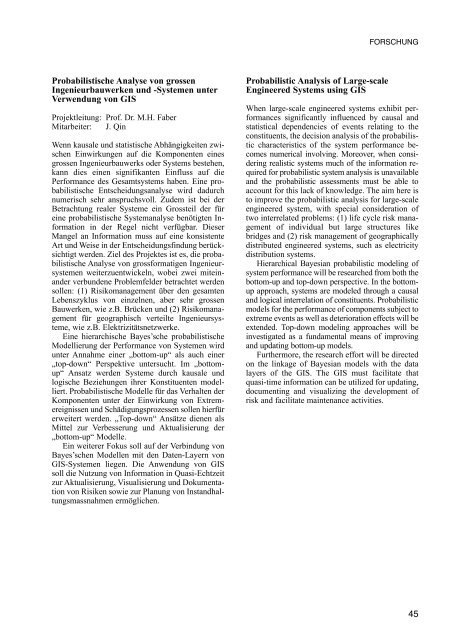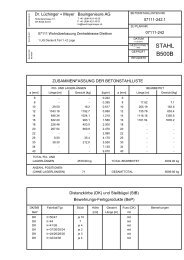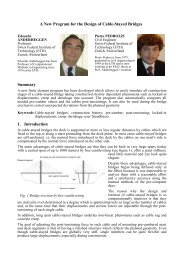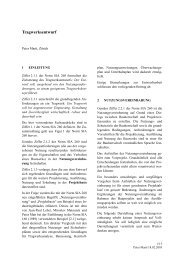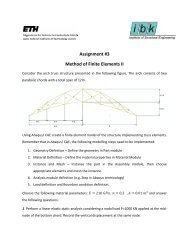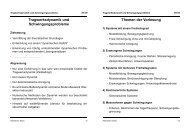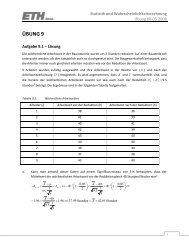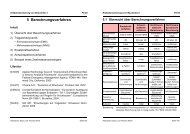JAHRESBERICHT - Institut für Baustatik und Konstruktion - ETH Zürich
JAHRESBERICHT - Institut für Baustatik und Konstruktion - ETH Zürich
JAHRESBERICHT - Institut für Baustatik und Konstruktion - ETH Zürich
Sie wollen auch ein ePaper? Erhöhen Sie die Reichweite Ihrer Titel.
YUMPU macht aus Druck-PDFs automatisch weboptimierte ePaper, die Google liebt.
FORSCHUNG<br />
Probabilistische Analyse von grossen<br />
Ingenieurbauwerken <strong>und</strong> -Systemen unter<br />
Verwendung von GIS<br />
Projektleitung: Prof. Dr. M.H. Faber<br />
Mitarbeiter: J. Qin<br />
Wenn kausale <strong>und</strong> statistische Abhängigkeiten zwischen<br />
Einwirkungen auf die Komponenten eines<br />
grossen Ingenieurbauwerks oder Systems bestehen,<br />
kann dies einen signifikanten Einfluss auf die<br />
Performance des Gesamtsystems haben. Eine probabilistische<br />
Entscheidungsanalyse wird dadurch<br />
numerisch sehr anspruchsvoll. Zudem ist bei der<br />
Betrachtung realer Systeme ein Grossteil der <strong>für</strong><br />
eine probabilistische Systemanalyse benötigten In -<br />
for mation in der Regel nicht verfügbar. Dieser<br />
Man gel an Information muss auf eine konsistente<br />
Art <strong>und</strong> Weise in der Entscheidungsfindung berücksichtigt<br />
werden. Ziel des Projektes ist es, die probabilistische<br />
Analyse von grossformatigen In ge nieur -<br />
sys temen weiterzuentwickeln, wobei zwei mitein -<br />
an der verb<strong>und</strong>ene Problemfelder betrachtet werden<br />
sollen: (1) Risikomanagement über den gesamten<br />
Le benszyklus von einzelnen, aber sehr grossen<br />
Bau werken, wie z.B. Brücken <strong>und</strong> (2) Risi ko ma na -<br />
ge ment <strong>für</strong> geographisch verteilte In genieur sys -<br />
teme, wie z.B. Elektrizitätsnetzwerke.<br />
Eine hierarchische Bayes’sche probabilistische<br />
Modellierung der Performance von Systemen wird<br />
unter Annahme einer „bottom-up“ als auch einer<br />
„top-down“ Perspektive untersucht. Im „bottomup“<br />
Ansatz werden Systeme durch kausale <strong>und</strong><br />
logische Beziehungen ihrer Konstituenten modelliert.<br />
Probabilistische Modelle <strong>für</strong> das Verhalten der<br />
Komponenten unter der Einwirkung von Ex trem -<br />
ereig nissen <strong>und</strong> Schädigungsprozessen sollen hier<strong>für</strong><br />
erweitert werden. „Top-down“ Ansätze dienen als<br />
Mit tel zur Verbesserung <strong>und</strong> Aktualisierung der<br />
„bot tom-up“ Modelle.<br />
Ein weiterer Fokus soll auf der Verbindung von<br />
Bayes’schen Modellen mit den Daten-Layern von<br />
GIS-Systemen liegen. Die Anwendung von GIS<br />
soll die Nutzung von Information in Quasi-Echtzeit<br />
zur Aktualisierung, Visualisierung <strong>und</strong> Doku men ta -<br />
tion von Risiken sowie zur Planung von In stand hal -<br />
tungs massnahmen ermöglichen.<br />
Probabilistic Analysis of Large-scale<br />
Engineered Systems using GIS<br />
When large-scale engineered systems exhibit performances<br />
significantly influenced by causal and<br />
statistical dependencies of events relating to the<br />
constituents, the decision analysis of the probabilis -<br />
tic characteristics of the system performance be -<br />
comes numerical involving. Moreover, when considering<br />
realistic systems much of the information re -<br />
quired for probabilistic system analysis is unavailable<br />
and the probabilistic assessments must be able to<br />
account for this lack of knowledge. The aim here is<br />
to improve the probabilistic analysis for large-scale<br />
engineered system, with special consideration of<br />
two interrelated problems: (1) life cycle risk ma na -<br />
gement of individual but large structures like<br />
bridges and (2) risk management of geographically<br />
distributed engineered systems, such as electricity<br />
distribution systems.<br />
Hierarchical Bayesian probabilistic modeling of<br />
system performance will be researched from both the<br />
bottom-up and top-down perspective. In the bottomup<br />
approach, systems are modeled through a causal<br />
and logical interrelation of constituents. Pro babilistic<br />
models for the performance of components subject to<br />
extreme events as well as deterioration effects will be<br />
extended. Top-down modeling approaches will be<br />
investigated as a f<strong>und</strong>amental means of improving<br />
and updating bottom-up mo dels.<br />
Furthermore, the research effort will be directed<br />
on the linkage of Bayesian models with the data<br />
layers of the GIS. The GIS must facilitate that<br />
quasi-time information can be utilized for updating,<br />
documenting and visualizing the development of<br />
risk and facilitate maintenance activities.<br />
45


